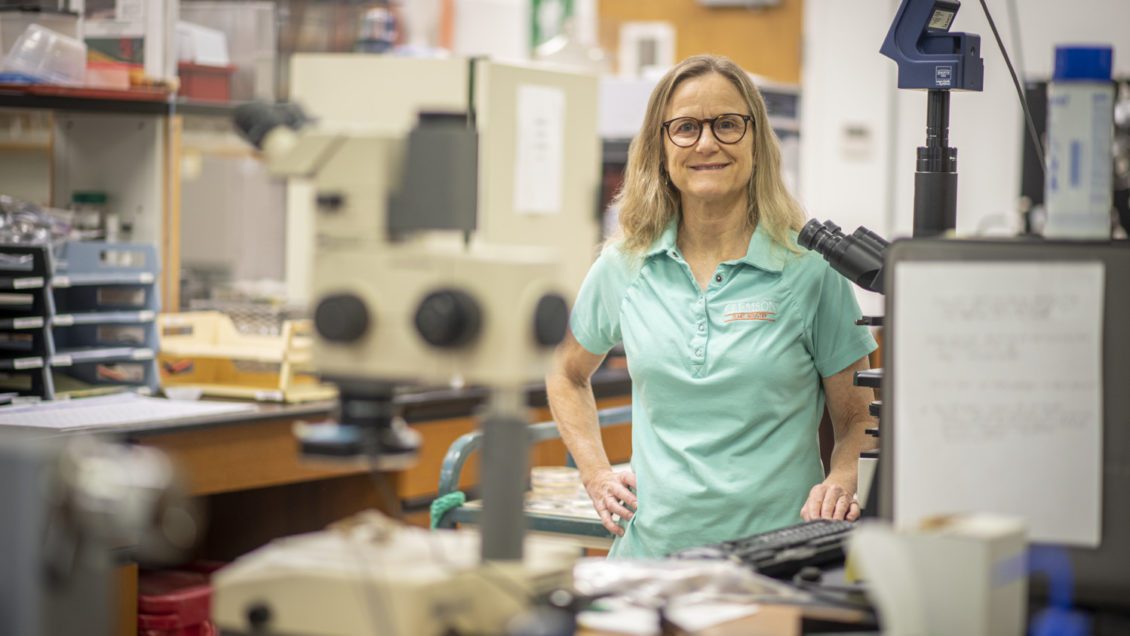Clemson University’s main campus covers some 17,000 acres, but the Tiger paw also adorns dozens of satellite campuses and research centers placed across the entire expanse of South Carolina. One of those orange dots on the map is the Plant and Pest Diagnostic Clinic in Pendleton, which is where you’ll find diagnostician and manager Meg Williamson.
Williamson spends her days on the front line of Clemson’s Land Grant mission diagnosing the condition of plant samples sent to her clinic by Clemson’s Cooperative Extension Service offices, homeowners, growers, landscapers, turfgrass management professionals and researchers. She is assisted by entomologists and a botanist in identifying insect and weed samples. She and her team use their findings to provide management recommendations, often with the assistance of faculty specialists. Another important function of the clinic is to detect and document new plant diseases and pests in South Carolina.

It’s important work that helps farmers, distributers, processors and other players in South Carolina’s agriculture industries, but Williamson says the benefits reflect back to campus too.
“We use scientific knowledge that’s been learned through the university and give that information to our clients – the people,” she said. “So, I help the people of the state, but I also work with researchers on campus. They send me samples if they have a problem with their research, and we do first reports on new diseases and things like that. And, I also work with students who come to the clinic to learn diagnostics.”
One of those students was Martha Froelich, who now works with Williamson as an assistant diagnostician.
“She’s really easy to work with,” said Froelich. “I think she really enjoys teaching. She’s got a wide range of experience, so she’s very knowledgeable. I came here when I was in graduate school, and Meg taught me a lot about diagnosing diseases that I wasn’t working on as a grad student. That really broadened my range of knowledge.”

Williamson’s clinic is part of Clemson Regulatory Services, which is a collection of employees throughout the state who are committed to protecting South Carolina from exotic and invasive species, providing diagnosis of plant pests, and ensuring readiness to respond to a catastrophic event impacting the state’s agriculture, among many other things.
It’s hard to overstate how valuable the work done by Williamson and her colleagues across Clemson’s extension services is to the state. A good example is Williamson’s discovery, several years ago, of a fungus that had been hiding underground in the roots of strawberries, quietly gathering strength until it could wage an all-out attack on the state’s strawberry crops.
“It’s called Fusarium crown rot,” said Williamson. “It was a big deal because strawberries are a big crop for South Carolina. I was looking for a different crown rot but found Fusarium instead. I worked with a fruit pathologist and one of his post docs on campus, and we were able to do a proof of pathogenicity and a first report for the state.”
Once Williamson and her teammates on the main campus verified the Fusarium as a pathogen, they alerted the state’s strawberry farmers, who in turn were able to adjust their production strategies, thus saving untold amounts in damaged crops.
It’s serious business, but it can also get a little wacky.
“When I first started working here, James Blake was the diagnostician, and one day I asked him what he was looking at,” Williamson recalled. “He said, ‘Well I’m diagnosing a UFO.’ I said ‘What??’ He said these people had gone out in their yard and found a big, greyish-black ring in their lawn and they thought for sure a spaceship had landed there and burned the grass!”

She grinned as she looked back on it: “They decided to send a sample to the clinic, and it turned out it was a slime mold. That’s the way they grow – out in a ring like that.”
In the last few years, Williamson has been able to extend Clemson’s impact beyond the state and even the country. In 2012, she accompanied a team of Clemson scientists on the first of four trips to Cambodia to teach sustainable agriculture and train extension agents there how to do disease diagnosis. She holds those experiences up as a highlight of her career.
“I learned about how to teach people,” she said, explaining that her job does not typically call for her to teach in a formal environment. “We did lectures and small laboratory teaching, and we had to have translators. It was challenging to teach that way. I learned a lot about how to organize a training.”
Williamson was born in New Mexico but grew up in Oak Ridge, Tenn. She was the middle of three children. She met her husband of 34 years, Joey, while the two attended graduate school at the University of Tennessee. Their son Duncan is 21 and did not fall far from the tree. A senior at Clemson, Duncan is studying environment and natural resources. All three are Tigers, as Joey is a senior extension agent for Clemson’s Home and Garden Information Center.
Both Meg and her husband use their experience and skills to provide recommendations to the public, which is the crux of what they do as service providers tasked with carrying out Clemson founder Thomas Green Clemson’s vision of improving the lives of South Carolinians through education and outreach in the agricultural and natural sciences.
“We don’t just do the diagnosis or the insect identification. We provide control recommendations so people will know what to do,” she explained. “That’s the bottom line. They want to know how to control the pests and we’re the ones that can tell them.”
Get in touch and we will connect you with the author or another expert.
Or email us at news@clemson.edu

